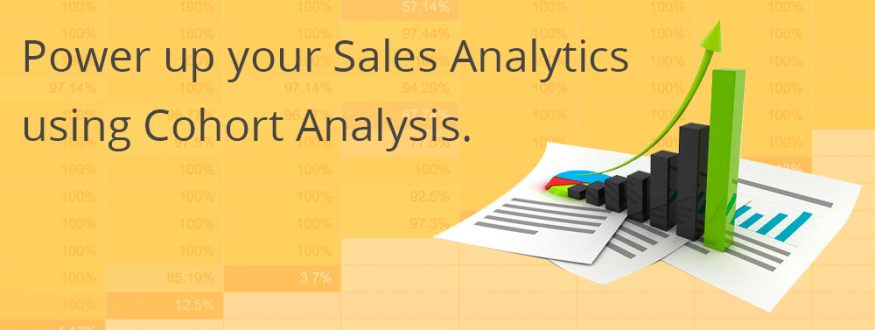A cohort is a group of subjects who share common characteristics in a given time span. Cohort analysis breaks down the data from a given dataset, like a web application or an online game, by putting it into related groups, or cohorts, for further study.
Alistair Croll and Benjamin Yoskovitz state in their book Lean Analytics that “a cohort analysis helps a company to see patterns clearly across the life-cycle of a customer rather than slicing across all customers blindly without accounting for the natural cycle that a customer undergoes.”
Cohorts can play an important role in analyzing and keeping track of important sales metrics. In this blog, we’ll discuss some scenarios that show how cohorts can be of value in sales analytics. This solution can be applied to the data present in Zoho CRM/Salesforce CRM or any such similar data source.
CUSTOMER RETENTION
Cohort visualization is a great way to analyze customer retention for subscription-based businesses. We can do that analysis by grouping customers based on when they first subscribed to a service (which we term as a cohort). The percentage of retention can be plotted for each of these cohorts across a varying time scale. Here’s an example:
As you can see, the month when a customer’s subscription started (i.e. the Month column) is the main cohort. The retention percentage for each cohort is plotted across a monthly time interval (month 1, 2, etc.). The actual customer count corresponding to that cohort is given under the Customers column.
Say, for instance, you look at Jan. 2015. You have 153 new customers with you. During the course of the year, you can see the percentage of the customers retained. For month 1 (i.e., February), 99.35% of the customers are retained, for month 2, 98.69% and so on. A percent decrease means customers have left you while an increase indicates that the same customers who left you have returned after a hiatus.
For quick inference, values are color coded to indicate a rise or fall in retention. 100% is given a dark shade of green while any fall is given progressively lighter shades of green (like 99.35%, 98.69%, etc). Shades of red are given to very steep falls in retention (in this case, less than 60%).
Cohort tables like the above help in analyzing datasets across timelines. It also makes it easier for decision-makers to evaluate the trends and take necessary steps to increase the retention rates. The above cohort was created using the pivot table feature of Zoho Reports.
SALES REPRESENTATIVES PERFORMANCE
Extending the previous case of customer retention, you can also measure the performance of your sales reps based on the number of customers each of them brings in and how effective the retention has been. See the example below:
The percent of customers a sales representative retains every month can be taken as a measure of the quality of customers a sales rep brings in and how the customers are nurtured/taken care, post sales. Here, that percentage can be seen horizontally across the rows, while the performance of each of the sales reps for a particular month can be seen vertically across the columns.
LEAD CONVERSION
You might have a thousand leads but not all of them get converted into opportunities (potentials/deals). Grouping those leads into cohorts can help you keep track of your leads, the percentage of conversion from leads to opportunities, and the percentage that were lost. Here is how Zoho Reports simplifies that task via a simple cohort:
Here, the first column indicates the time period for which the leads are created, the second column shows the number of leads brought in, and the subsequent columns indicate the percentage of conversion during each of the months from then on. By generating a report like this, you can use the month-to-month conversion data to start thinking about ways to increase your conversion rate. You can also see that maximum conversions happen within the first 5 months and that they start dwindling after that.
POTENTIAL CONVERSION
You can go a step ahead from tracking your leads to tracking how many of your opportunities (potentials/deals) get converted into wins. Here is a simple cohort exhibiting that:
Here, the first column indicates the time period during which the opportunities were created, the second column shows the number of opportunities (potentials/deals) brought in, and the subsequent columns indicate the percentage of conversion of potentials during each of the months from then on.
Although we’ve been talking about cohorts from a CRM perspective, we can extend that discussion to many other domains. So make sure you read our upcoming posts to learn more about creating cohorts in other areas. In the meantime, check out our solution page to get a step-by-step set of instructions on how to generate cohorts described in this blog using Zoho Reports.
Want to create your own cohorts?

